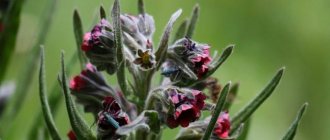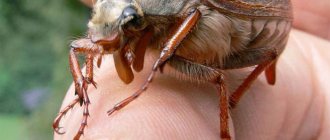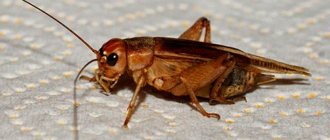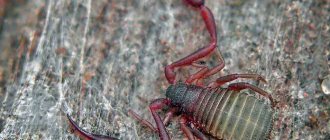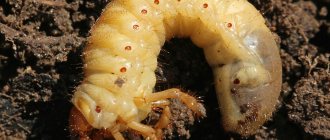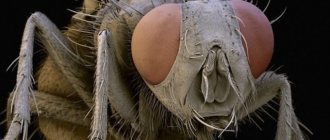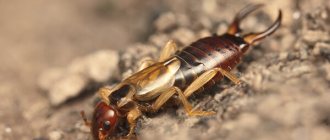What they look like
The size of adult individuals is 2-3.5 cm. Male insects are much larger than females. A characteristic feature of the beetles is their large head, which smoothly turns into the chest. Powerful jaws stand out on the head. Males also have fangs.
Almost 1/3 of the body of insects falls on the convex abdomen. Beetles don't have wings. Insects live underground, do not fly, but crawl. The chitinous cover of the body is black with a blue tint. The body of insects rests on short legs with claws.
Snow beetles lay large larvae. They hatch into thick caterpillars with a dark head and off-white body. The length of the caterpillar can reach 4 cm. Upon completion of their development cycle, they pupate. They spend the winter in this state. The period of transformation of caterpillars into beetles is May.
Features of reproduction
The method of reproduction of this beetle is very interesting. The female and the male immediately after mating equip themselves with a common home - a burrow up to 70 cm long. The female digs out chambers and lays white oval-shaped eggs 0.5 cm in size in them. It should be noted that the architecture of the burrows is quite complex, they even have kind of drainage systems.
The female lays a total of 2 to 15 eggs, the development of which occurs over 10 days. During this time, the beetles prepare food by cutting off green shoots of plants with their jaws. From the cut parts, the kravchiki make a kind of silage cube, while soaking the vegetation with their own saliva.
Insects carry these cubes into the chambers, and after they are completely filled, the entrance to the hole is covered with earth. Fermentation of the plant mass ends with its transformation into a kind of silage. The newly emerged larvae feed on food prepared by their caring parents. By consuming silage, the white, gnarled larvae with a small head and short legs grow rapidly.
After 18-22 days, when the length of the larvae reaches 4 centimeters, they turn into pupae. After about 2 weeks, the pupae hatch into adults, who spend the autumn and winter in the dwelling built by their parents. They crawl out of their holes only in the spring. Adult beetles dig burrows for wintering next to the home of their offspring.
Habitats and food
Insects live in earthen burrows, into which they drag their green food and compact it.
Under the influence of bacteria, the vegetation brought into the burrows begins to rot, turning into silage. This mass is the main food for beetles. The powerful jaws of insects allow them to cut leaves, shoots, inflorescences and even young grapevines. Snow beetles differ from other beetles in that they do not feed on excrement.
They pose a great danger to agricultural plants. In one day, one insect can destroy up to 10 grapevine shoots.
Why is it dangerous?
In the wild, the presence of the beetle is practically not felt. Lives in the ground, cuts grass, helps loosen the soil.
But the black beetle in the garden turns into a real agricultural pest.
The insect prefers hard ground, untouched lands, but often approaches human possessions in search of more “tasty” food.
Important! Absolutely all crops in the vegetable garden, flower beds, and gardens can suffer from the activity of beetles. With powerful jaws, pests calmly cut off young shoots, stems, leaves, and flowers.
A dozen adult individuals per season can destroy a young vineyard, a bed of wild strawberries, or strawberries.
Krawczyk is not dangerous to humans; he will never attack first. It may pinch the skin in defense if you pick it up.
What harm can they do?
Insects pose a danger to garden crops, garden and ornamental plants. Having settled in a summer cottage, they begin to actively devour any types of seedlings, garden shrubs, vegetables in the beds, and even corn and sunflowers. Insects can cause great damage to grapes.
Pests indiscriminately destroy all crops encountered in their path. The inhabitants of 2-3 earthen burrows are capable of destroying vegetation on an area of 5-7 sq.m. in a short period of time.
Sensing danger from a person, the crayfish can bite him. These bites do not pose a danger to people, but are extremely unpleasant.
May beetle (Khrushchev)
If the cockchafer itself is primarily one of the main pests of forest and fruit and berry plantings (it feeds on buds, needles and leaves of trees and shrubs), then in the garden the main problems are caused to plants by thick white insect larvae (furrows).
They live and develop in the soil for several years, all this time actively feeding on the roots and tubers of almost any herbaceous plants and trees, causing significant damage to cultural plantings - young plants die, older ones are stunted in growth.
Measures to combat the cockchafer must be an integrated approach, otherwise they will be ineffective. And this includes the indispensable mulching of the soil, and collecting beetles and larvae by hand, and planting repellent plants (clover, elderberry, lupine, etc.), and the use of both biological (Nemabact) and chemical (Antikhrushch, Zemlin) drugs.
- May beetle: which plants are threatened and how to deal with its larvae
The appearance of cockchafers in the garden is not a harmless sight, but a serious problem. Don't let pests destroy your plants!
Control measures
It is difficult to clear the area of snowflakes. You need to start fighting it immediately at the first signs of insects appearing in the garden or vegetable garden. The fight against them is complex.
Agrotechnical works
This type of insect control is used simultaneously with insecticidal treatment or the use of folk remedies. This is the only way to cope with the problem that has arisen. Agrotechnical work includes digging or plowing a summer cottage. The depth of digging the soil should be at least 30 cm. Work is carried out in the fall. In the spring, the soil on the site must be loosened.
These measures help destroy the insect burrows that they build in the ground. As a result, both adults and larvae die. An equally common method of control is mechanical collection and destruction of beetles. They are collected early in the morning. The process is labor-intensive, but also effective. Since insects do not have wings, you can enclose the area with a solid, buried fence.
Expert opinion
Mityuk Stefania Bogdanovna
Very often, summer residents use sunflower oil to control pests. They fill insect holes with it. It blocks the entrance of insects into the burrows and blocks the respiratory functions of the swifts. After filling the holes with oil, the beetles crawl out and die. Instead of sunflower oil, you can use polyurethane foam.
Chemical control methods
Pest control with this method involves the use of insecticides and special traps. The latter are arranged in grooves that are arranged along the perimeter of the site. Dig them to a depth of 25-30 cm. Grass, previously soaked in an insecticide solution, is placed at the bottom of the groove. The beetles will definitely gather in these grooves and receive their lethal dose of poison.
Traditional methods
The most popular folk methods of pest control include treating the soil with a solution of laundry soap or boiling water. They fill beetle holes. They carry out work early in the morning, while the snowbirds have not yet crawled out to the surface. Such methods are environmentally friendly. Processing needs to be done several times.
There are many passages in beetle holes where they can hide when filled with soapy water or boiling water. Traditional methods of controlling insect pests are used from April to June while the larvae have not yet turned into beetles.
The following are used as preventive measures to protect against kravchik:
- fencing grape shoots, tomato seedlings, eggplant and peppers with plastic bottles or aluminum cans;
- strawberry beds and flower beds are fenced with borders made of slate, metal sheets or boards;
- beet, garlic and onion beds are raised to a height of 10-15 cm and their walls are made steep;
- seedlings are planted in beds in plastic cups with a cut out bottom.
Have you ever had to fight snow beetles?
Was the caseNever
Strigun beetle, or kravchik: description
The insect is considered a dangerous agricultural pest from the family of dung beetles, of which there are more than 130 species. Unlike other species that consume animal excrement, the krawchik is a “vegetarian”.
The crayfish can live in almost any place - on forest edges, in steppes or forest-steppes, on plains. They can be found in plowed agricultural fields, gardens and vegetable plots. The largest number of pests live in southern Polesie.
It is also useful to read: Who is a bear and how to get rid of it forever
Appearance
The snow beetle is a large insect - the size of its body reaches 3-3.8 cm. The male is much larger than the female. Its appearance has some features:
- black matte color of the body, covered with a dense chitinous shell;
- large, flattened head with large jaw apparatus;
- the insect's mouthparts are equipped with powerful fang-like processes to repel enemies, but females do not have fangs;
- the beetle's eyes are located on the sides of the head;
- on the head of the insect there are antennae with brush-like thickenings at the tips;
- a convex, rounded abdomen with a wide chest;
- The crowfish has three pairs of legs with bristles and strong claws for digging the ground.
Reference! The snow beetle does not have wings, so it cannot move through the air.
Its main “weapons” are considered to be a powerful jaw apparatus and paws with strong claws, allowing it to dig the ground and build holes for oviposition and wintering.
These photos show what a snow beetle looks like:
In this video you can clearly see the snow beetle:
Nutrition and lifestyle
The snow beetle, unlike other dung beetles, feeds exclusively on food of plant origin. He uses:
- buds, inflorescences, leaves and shoots of grapes;
- any seedlings;
- garden plants;
- garden shrubs;
- row crops – sunflower, corn.
Reference! The snow beetle destroys green spaces with the help of strong jaws and claws on its feet, thanks to which it is able to bite through even woody grapevines.
The insect carries the plant food into the burrow and compacts it tightly so that it rots into silage. It is the main food supply for adults and larvae.
Development cycle
With the first days of spring, the snow beetle begins to dig holes in the ground - their depth can reach 40-60 cm, in which they live. Inside the hole, the insect digs out a special depression in which the female lays eggs.
In one burrow, the female insect lays up to 15-20 eggs , which she then covers with earth, having previously left leaves, flowers and other plant food there. Kravchik eggs are large in size and can reach up to 7-8 mm.
In the “sealed” hole, the plants turn into silage, which the larvae feed on. After laying eggs, adults die or go into prolonged hibernation.
The development cycle of the snow beetle consists of three phases - eggs are laid, which after 20-21 days become pupae, and after another 14-15 days they turn into adults.
The best chemicals
Insecticides are used to control insect pests. The best time to treat the soil with them is during the flowering period of apple trees. For the most part, chemicals are not able to completely destroy snowbirds. They hide in their burrows and wait out the processing time. To achieve a positive effect, the soil is treated during insect breeding.
Along with soil cultivation, plant foliage can be sprayed with chemical solutions. Insects escaping from the effects of the drugs are collected by hand and burned. When preparing solutions, it is important to strictly follow the dosage recommended by the manufacturers.
"Decis"
The drug has a universal effect. It is a pesticide and is widely used in agriculture to treat grain crops and melon crops. In summer cottages I use it to destroy various insect pests that eat garden plants, flower beds and harm garden trees and shrubs.
Decis is often used as a preventative plant protection product. The product effectively kills not only beetles, but also flies, cockroaches, bedbugs, wasps, moths and fleas. The pesticide is completely useless for fighting ticks and mosquitoes.
The main component of the drug is deltamethrin. This is an analogue of a natural substance found in plants of the Pyrethrum family. "Decis" is produced in the form of 2.5% and 12.5% emulsion, as well as in the form of 25% Profi granules.
The emulsion is bottled in 0.6 mg bottles and ampoules of 2 ml, granules are packaged in 1 g bags. For large farms, manufacturers bottle ready-to-use solutions of the drug into 5 liter canisters.
"Decis" refers to drugs with contact-intestinal action. Once inside the insect, it removes and destroys nerve fibers. Insects lose the ability to move, feed and die within 5 minutes.
After treatment, the drug retains its properties on plants for another 2 weeks. It is resistant to rainfall.
Advantages:
- efficiency;
- speed and long-term action;
- adaptation for all climatic zones;
- lack of phytotoxicity;
- does not accumulate in the soil;
- safe for earthworms;
- does not penetrate into plant fruits.
Flaws:
- toxicity;
- partially loses properties at t +27°C;
- cannot be used near ponds and apiaries.
"Decis" is not addictive, so it can be used repeatedly. When working with the drug, it is imperative to observe safety precautions.
"Arrivo"
The drug is used to destroy adult beetles, their larvae and eggs. The main component of the product is cypermethrin. It has a depressing effect on crawling and flying insect pests.
The product is produced in the form of an emulsion, packaged in 1.5 ml ampoules. “Arrivo” is used not only to combat crabweed, but also to kill flies, cockroaches and fleas.
When eating plants treated with the drug, the poison penetrates the insects, causing paralysis of their nervous system and death. Arrivo has an active effect on plants for 20 days after treatment. After this period, it is recommended to re-treat the plants.
Advantages:
- efficiency;
- ease of use;
- resistance to adverse weather and temperature changes;
- speed and long-term action.
Flaws:
- cannot be used to treat areas near ponds and apiaries;
- When working with the drug, precautions must be taken.
Arrivo solution is used to treat soil and plants. It is prepared from a bucket of water and 1 ampoule of the product. The solution is sprayed onto the plants using a spray bottle.
When treating areas for beetles, maximum attention is paid to garbage heaps.
The consumption rate of the solution per 1 sq.m depends on the type of plant. For example, for grapes it is 200 ml, for fruit trees - 380 ml, potatoes - 160 ml, melons - 320 ml.
"Karate"
Powerful insecticide with universal action. Used to destroy insect pests of agricultural crops at any stage of their development.
The main component of the drug is lambda-cyhalothrin. Manufacturers produce the drug in the form of an emulsion, packaged in ampoules.
To treat plants, “Karate” is diluted with water. The dosage of the drug is indicated on its packaging. "Karate" has a delayed effect. It begins to act 2-3 hours after treating the plants.
In people suffering from allergies, “Karate” can provoke an attack.
Advantages:
- high efficiency;
- does not kill earthworms;
- resistance to rainfall and solar radiation;
- can be used as a preventive plant protection product.
Flaws:
- negative impact on the fauna of the ecosystem;
- When working with the drug, precautions must be taken;
- Do not treat areas near water bodies.
How to get rid of longhorned beetle using chemicals
If longhorned beetles are found in the house, you need to immediately take measures to destroy them. In order for wood to last as long as possible, it must be processed before building a house. As a rule, they use a fumigation method based on phosphine gas. If the tree has not been treated, then beetles will definitely appear. Then you will have to do a series of actions.
For example:
- First of all, it is necessary to check the extent of damage to the wood. To do this, take a screwdriver and use it to pierce the wooden structures. If the tool easily fits into the wood, then it is better to replace such structures.
- Those structures that the beetle has not yet reached must be treated with special liquids. Before this, wooden structures are cleaned with a wire brush, after which all dust and sawdust must be removed with a vacuum cleaner. After this, the surfaces are treated with an insecticide. Before this, everyone living in the home is evacuated and the windows and doors are tightly closed.
- In cases of severe infection, syringing is carried out. To do this, holes are drilled in the wood with a thin drill, in increments of 3 cm, and an insecticidal solution is injected into them using a syringe.
There are many products available on the chemical control market to kill all types of insects. In such cases, it is better to choose liquids, since they can penetrate the wood structure and destroy the larvae there.
What types of insecticides are there:
- Contact action . Insects and their larvae die upon contact with the chemical. These products are rarely used, since working with them can cause poisoning.
- Intestinal action . If it enters the intestines of an insect or larva, the substance leads to death. Based on such components, baits are made, which include an insecticide and an aromatic substance to attract insects.
- Fumigants . They emit gases that are toxic to insects.

